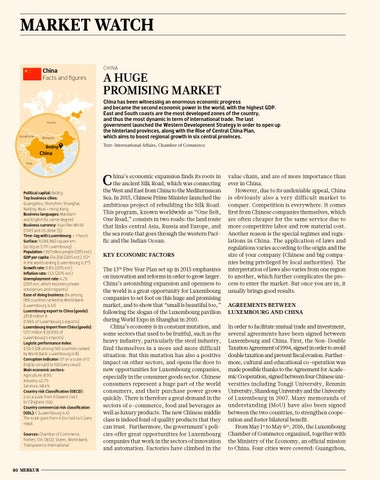MARKET WATCH China Facts and figures
Russia
Kazakhstan
Mongolia
Beijing
CHINA
A HUGE PROMISING MARKET
China has been witnessing an enormous economic progress and became the second economic power in the world, with the highest GDP. East and South coasts are the most developed zones of the country, and thus the most dynamic in term of international trade. The last government launched the Western Development Strategy in order to open up the hinterland provinces, along with the Rise of Central China Plan, which aims to boost regional growth in six central provinces. Text: International Affairs, Chamber of Commerce
China India
C Political capital: Beijing Top business cities: Guangzhou, Shenzhen, Shanghai, Nanjing, Wuxi + Hong Kong Business languages: Mandarin and English (to some degree) Business currency: Yuan Ren Min Bi (CNY) and US dollar ($) Time-lag with Luxembourg: + 7 hours Surface: 9,596,960 square km (as big as 3,711 Luxembourg) Population: 1.367 billion people (2015 est.) GDP per capita: $14,300 (2015 est.), 112th in the world ranking (Luxembourg is 2nd) Growth rate: 6.8% (2015 est.) Inflation rate: 1.5% (2015 est.) Unemployment rate: 4.2% (2015 est., which excludes private enterprises and migrants) Ease of doing business: 84 among 189 countries ranked by World Bank (Luxembourg is 61) Luxembourg export to China (goods): 231.8 million € (1.96% of Luxembourg’s exports) Luxembourg import from China (goods): 121.1 million € (0.69% of Luxembourg’s imports) Logistic performance index: 3.53/5 (28 among 160 countries ranked by World Bank. Luxembourg is 8) Corruption indicator: 37 on a scale of 0 (highly corrupt) to 100 (very clean) Main economic sectors: Agriculture: 8.9% Industry: 42.7% Services: 48.4% Country risk Classification (OECD) : 2 on a scale from 0 (lowest risk ) to 7 (highest risk) Country commercial risk classification (ODL): C (Luxembourg is A) The scale goes from A (no risk) to C (very risky). Sources: Chamber of Commerce, Forbes, CIA, OECD, Statec, World Bank, Transparency International.
80 MERKUR
hina’s economic expansion finds its roots in the ancient Silk Road, which was connecting the West and East from China to the Mediterranean Sea. In 2015, Chinese Prime Minister launched the ambitious project of rebuilding the Silk Road. This program, known worldwide as “One Belt, One Road,” consists in two roads: the land route that links central Asia, Russia and Europe, and the sea route that goes through the western Pacific and the Indian Ocean.
KEY ECONOMIC FACTORS The 13th Five Year Plan set up in 2015 emphasizes on innovation and reforms in order to grow larger. China’s astonishing expansion and openness to the world is a great opportunity for Luxembourg companies to set foot on this huge and promising market, and to show that “small is beautiful too,” following the slogan of the Luxembourg pavilion during World Expo in Shanghai in 2010. China’s economy is in constant mutation, and some sectors that used to be fruitful, such as the heavy industry, particularly the steel industry, find themselves in a more and more difficult situation. But this mutation has also a positive impact on other sectors, and opens the door to new opportunities for Luxembourg companies, especially in the consumer goods sector. Chinese consumers represent a huge part of the world consumers, and their purchase power grows quickly. There is therefore a great demand in the sectors of e-commerce, food and beverages as well as luxury products. The new Chinese middle class is indeed fond of quality products that they can trust. Furthermore, the government’s policies offer great opportunities for Luxembourg companies that work in the sectors of innovation and automation. Factories have climbed in the
value chain, and are of more importance than ever in China. However, due to its undeniable appeal, China is obviously also a very difficult market to conquer. Competition is everywhere. It comes first from Chinese companies themselves, which are often cheaper for the same service due to more competitive labor and row material cost. Another reason is the special regimes and regulations in China. The application of laws and regulations varies according to the origin and the size of your company (Chinese and big companies being privileged by local authorities). The interpretation of laws also varies from one region to another, which further complicates the process to enter the market. But once you are in, it usually brings good results.
AGREEMENTS BETWEEN LUXEMBOURG AND CHINA In order to facilitate mutual trade and investment, several agreements have been signed between Luxembourg and China. First, the Non-Double Taxation Agreement of 1994, signed in order to avoid double taxation and prevent fiscal evasion. Furthermore, cultural and educational co-operation was made possible thanks to the Agreement for Academic Cooperation, signed between four Chinese universities including Tongji University, Renmin University, Shandong University and the University of Luxembourg in 2007. Many memoranda of understanding (MoU) have also been signed between the two countries, to strengthen cooperation and foster bilateral benefit. From May 1st to May 6th, 2016, the Luxembourg Chamber of Commerce organized, together with the Ministry of the Economy, an official mission to China. Four cities were covered: Guangzhou,
